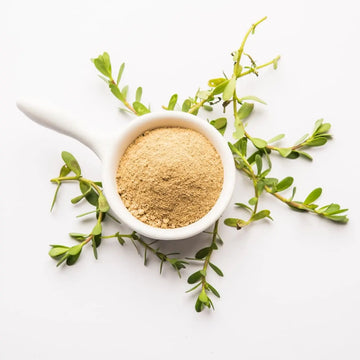Shatavari: An Ayurvedic Herb for Hormonal Balance and Women's Well-being
Contents
Entry
The female life cycle consists of different stages, each of which brings profound physical and psychological changes. The first significant moment in every woman's life is menarche, the beginning of menstruation. The term comes from the Greek language, where men means month, and arkhe beginning.
The first period, or menarche, is considered a major turning point that is regulated by the pineal gland, a tiny teardrop-shaped gland deep in the brain. The pineal gland is responsible for producing melatonin, a hormone that regulates our circadian rhythm. Studies suggest that melatonin levels also affect the menstrual cycle and the onset of menstruation. 1 2 Today, the average age of menarche is around 12-13, although in the past it was around 17. 3 This change may be related to exposure to artificial light and modern diet, which affect the functioning of the pineal gland and therefore the earlier onset of menstruation.
After menarche, a woman goes through a period in which she has menstrual cycles. This cycle of a woman's life is not limited to the ability to reproduce, however; it is also a period of pursuing other goals related to running a household or developing a career.
Another important stage in a woman’s life is menopause, a natural process that usually begins around age 50. Menopause marks the end of menstruation and, therefore, the end of fertility. However, the transition to menopause, known as perimenopause, can begin up to 3 to 10 years earlier. Understanding and being aware of your menstrual cycle can support a smoother transition to menopause and help maintain hormonal balance at every stage of life 4 .
What is Shatavari?
Shatavari, also known as asparagus , is an herb with a rich history of use in Ayurveda. The name "Shatavari" literally means "woman with a thousand husbands," indicating its traditional use as a tonic for the female reproductive system. This herb plays a key role in toning and supporting the female body, starting at menarche (first period), throughout reproductive life, and into menopause.
Shatavari - Health Benefits
Hormonal balance and reproductive system support
Shatavari is valued for its hormonal balancing properties. In Ayurveda, this plant is used at every stage of the menstrual cycle – it supports regular menstruation, relieves the symptoms of PMS (premenstrual syndrome) and has a soothing effect on the reproductive system. During menopause, Shatavari helps relieve troublesome symptoms such as hot flashes, irritability, memory problems and dryness, while supporting circulation and functioning of the nervous system.
Fertility and lactation support
Shatavari is also considered a powerful fertility tonic. With its moisturizing and regenerative properties, Shatavari supports ovarian health and hormonal balance, which is crucial for fertility. Additionally, after childbirth, this herb is often used to support lactation, increasing milk production and improving its quality.
Building ojas – the essence of resilience and vitality
Ojas is an Ayurvedic concept that refers to the essence of immunity, vitality, life force and quality of sleep. Shatavari is known for its ojas-building effect, which contributes to an overall increase in the body's immunity, improved sleep quality and overall well-being. Regular use of Shatavari can therefore help increase life energy, reduce stress and strengthen the immune system.
Other properties of Shatavari
Antioxidant and anti-stress effect
Shatavari is rich in antioxidants, which protect the body from the harmful effects of free radicals. Studies have shown that supplementing with Shatavari can improve the body's antioxidant defenses by increasing the activity of antioxidant enzymes and reducing oxidative damage. In addition, Shatavari supports the production of chemicals in the brain that have anti-anxiety, anti-stress, and anti-depressant effects. Therefore, shatavari can be a natural support during periods of mental stress.
Action supporting the digestive system
Shatavari has the ability to alleviate stomach problems by strengthening the protective mechanisms of the mucosa, increasing mucus secretion and its viscosity, which helps protect the stomach walls from damage.
Anti-yeast and immune-supporting effects
Asparagus racemosus has antifungal activity, including against yeasts of the genus Candida . Studies have shown that Shatavari extracts have high antimicrobial activity, comparable to fluconazole, a commonly used antifungal drug. Furthermore, Shatavari supports the immune system by stimulating immune cells and increasing the body's resistance in normal and immunocompromised states.
Ayurvedic Classification Shatavari
Shatavari is a herb that is classified in Ayurveda according to its various properties:
- Taste (Race): Bitter, sweet
- Energy (Virya): Cooling
- Effect after digestion (Vipaka): Sweet
- Quality (Guna): Oily, heavy
- Influence on Doshas (Dosa): Reduces Vata and Pitta levels, increases Kapha
- Tissues (Dhatu): It works on all tissues
- Channels (Srota): It affects the digestive system, female reproductive system and respiratory system.
Due to these properties, Shatavari is considered a hydrating and cooling herb, which is especially beneficial for Pitta women who may experience excess heat, irritability, or inflammation.
How to use Shatavari from Sattva?
Shatavari by Sattva is available in a vegan capsule form. This is a very simple and convenient form. One capsule a day taken regularly with a meal allows you to feel the positive effect within 1-2 weeks (although this time may vary from person to person).

Summary
Shatavari is a multi-faceted herb that plays a key role in supporting women’s health and well-being. Its ability to harmonize hormonal balance, support the reproductive system, and build ojas makes it an essential part of the Ayurvedic medicine cabinet. Shatavari is an ideal choice for women of all ages who want to take care of their health in a natural way, in accordance with the Ayurvedic tradition.
Footnotes
- Sizonenko PC. "Physiology of puberty." J Endocrinol Invest. 1989;12(8Suppl 3):59-63.
- Barron ML. "Light exposure, melatonin secretion, and menstrual cycle parameters: an integrative review." Biol Res Nurs. 2007;9(1):49-69. doi:10.1177/1099800407303337.
- Bobby Clennell. The Woman's Yogi a Book , p. 9.
- Christine R. Page. The Healing Power of the Sacred Woman: Healthy, Creativity and Fertility for the Soul , Chapter 6, Moon Time.
- Malviya N, Jain S, Gupta VB, Vyas S. "Recent Studies on Phytoestrogens in the Management of Menopausal Symptoms." International Journal of Pharmaceutical Sciences and Research , 2011; 2(3): 542-548.
- Rai S, Wahile A, Mukherjee K, Saha BP, Mukherjee PK. "Antioxidant Activity of Asparagus racemosus Willd." Indian Journal of Experimental Biology , 2005; 43(9): 835-841.
- Sharma V, Chauhan NS, Dixit VK. "Effect of Asparagus racemosus on Depression and Anxiety Symptoms in Postmenopausal Women: A Randomized, Double-blind, Placebo-controlled Study." Journal of Ethnopharmacology , 2011; 135(1): 118-122.
- Uma B, Prabhakar K, Rajendran S. "Anticandidal Activity of Asparagus racemosus ." Indian Journal of Pharmaceutical Sciences , 2009.
- Sharmaa, Punita, et al. "A Unique Immuno-Stimulant Steroid Sapogenin Acid from the Roots of Asparagus racemosus ." Steroids , 2011.



